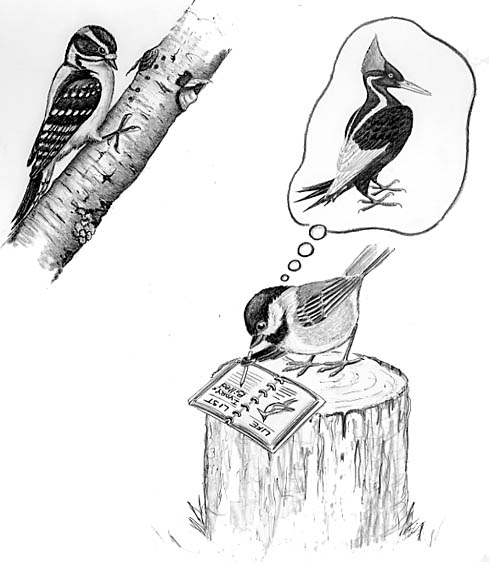
Dear Bird Folks,
I would like to start keeping a list of all the birds that I see, but I don’t know where to start. Are there preprinted lists or books that I can simply fill in, or should I just make my own? Also, I just turned fifty-years old and am wondering if it’s “legal” for me to include birds that I’ve already seen or do I need to start fresh?
– Dave, NJ
You are brave, Dave,
It takes a man to admit that he has just joined the Half-Century Club, especially in public. I still don’t have enough guts to do that myself. In fact, last week I went to see a guy who makes fake ID’s for old people. For a mere twenty bucks I was able to move out of the Half-century Club and become a hip kid again. Unfortunately, I didn’t do the math right and I told the guy I wanted my birth year to be 1997. That was a big mistake. On the way home I got stopped by a cop who was shocked to see that I was only eleven-years old. Luckily, he didn’t give me a ticket but I was grounded for a week and couldn’t watch TV for a month. I forgot how tough being eleven was.
I think we touched on the topic of keeping a life list a few weeks ago. As a quick refresher, a life list is list of birds that one person is able see in his or her lifetime. It’s pretty cut and dry and not all that exciting, but if you are into it, it can be kind of fun. For many people adding to their life list serves as motivation for them to get up and go outside more often. It’s hard to see new birds by sitting on the couch all day; goodness knows, I’ve tried.
Yes, Dave, of course you can count birds that you saw before you officially started to keep a list, if you want to. I certainly would. But it’s your list so you make the rules. That’s what’s nice about keeping a bird list; it’s one of the few things in life where you can make your own rules. There is one rule, however, that you should probably follow. It’s really not cool to add a bird to your list unless you are close to 100% certain you have identified it correctly. Don’t be checking off birds on a hunch. If you are going to do that, then you might as well check off every bird on day one and go back to sitting on the couch.
Checking off birds prematurely can be a problem for younger birders who are eager to build up their list. I’ve looked back at some of my early lists and there are birds on it that I know I never saw. For example: The penguins that I thought were eating underneath my bird feeder were probably juncos. I had just gotten my first pair of binoculars and was having a little trouble with judging proper size.
There are a number of ways to keep a life list. You can simply write down every new bird you see on a pad of paper. Done and done. Or, like I used to do, make a check mark in your field guide, right next to the bird’s picture. That way you don’t have to keep an extra book. All of your info is with you every time you go birding. The downside of using your field guide for your life list is that you may lose it while you are out birding…like I did when I fell into the ocean while trying to see puffins. That’s when I decided to keep two lists. You can still check off birds in your field guide, but keep a second, more detailed list at home, away from the ocean.
Again, your second list can be on a simple pad of paper; however, there are also some very good birding journals that you can buy, and buying birding stuff is something I’m never afraid to encourage. One such book, the Birder’s Life List & Diary, is put out by Cornell’s Lab of Ornithology. It lists the birds in taxonomic order, which means that all the woodpeckers, warblers, ducks, etc. are listed together. The diary also has a place where you can write the date, location and other pertinent information about the sighting. What I like best about this book is that it’s spiral bound, so it easily lies flat when you want to write in it. Another good choice is National Geographic’s Birder’s Journal. It is somewhat similar to the Cornell book, but it has black and white illustrations of each bird, which is a plus. However, this book is very thick (500 pages), not spiral bound, and tough to keep open. Making notes in it is like writing with your hand stuck in a bear trap. Not fun at all.
I’m glad you are thinking about keeping a life list, Dave. It’s a great motivator to do more birding. Also, congrats on turning fifty. I’ll be there myself soon…only another thirty-nine years to go.